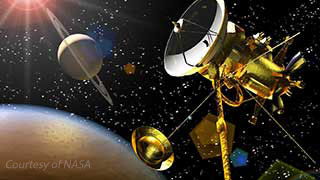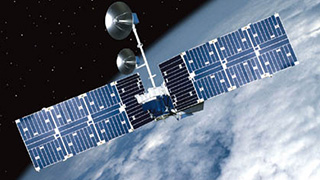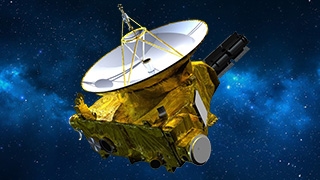Houston, We Have a Networking Problem
June 13, 2018
 This
article first appeared on Network World, by IDG contributor Brent Dietz.
This
article first appeared on Network World, by IDG contributor Brent Dietz.
We’ve covered networking on our home planet. But what happens when we send signals where no man has gone before?
Space networking is two-way communication between base stations on Earth, and unmanned space probes, planetary rovers, orbital satellites or manned spacecraft. These radio signals bring back messages, images and scientific discoveries. Someday they’ll be used to communicate between colonies on Earth and the moon or Mars.
Of course, we can’t just “call” Mars. Networking in outer space is vastly different from what we experience on Earth.
Communications travel at the speed of light. This means that it can take 20 minutes or more for a radio signal to reach a Martian planetary rover. It’s like going back to dial-up.
You’ve Got Mail.
Beyond egregiously slow communications, space networking faces reliability challenges. Scientists can’t exactly order a space probe back to the lab if it malfunctions near Pluto. Or open the trunk of a Mars rover and pull out a spare if it freezes up on the Martian surface.
All the components in space communications systems must tolerate high radiation levels, wild temperature fluctuations and a long useable life. Space.com reported that “the radiation dose received by an astronaut on even the shortest Earth-Mars round trip would be about 66 rems. This amount is like receiving a whole-body CT scan every five or six days.”
Temperature also impacts reliability. Outside Earth’s atmosphere, objects in sunlight can reach 248 degrees Fahrenheit, while shaded objects can hit minus 148 degrees Fahrenheit. On Mars, the temperature varies between negative 284 and 86 degrees Fahrenheit, according to NASA.
For systems like the Mars Rover, power efficiency is another challenge.
What good is a rover that uses up its power supply before transmitting data or
images back to Earth?
One small step for GaN (and GaAs)
The unforgiving realm of deep space is a perfect place for gallium arsenide (GaAs) and gallium nitride (GaN). Both compound semiconductor technologies are necessary for the inherently challenging conditions of space exploration and, most importantly, communications back to Earth.
GaAs is a compound semiconductor that has been the de-facto standard in space applications for decades. GaAs amplifiers and switches are rugged and dependable, and have been aboard several space platforms, including communications and navigation satellites.
 However, the new and emerging standard is GaN. GaN
solutions operate reliably, at higher temperatures, for 100 times longer than
legacy technologies. GaN also delivers higher output power and data throughput
in a smaller package, reducing energy consumption by as much as 20
percent.
However, the new and emerging standard is GaN. GaN
solutions operate reliably, at higher temperatures, for 100 times longer than
legacy technologies. GaN also delivers higher output power and data throughput
in a smaller package, reducing energy consumption by as much as 20
percent.
Hundreds of thousands of GaAs and GaN-based networking solutions have launched aboard space applications. These include orbital satellites, which support critical programs like Boeing's Spaceway for broadband data, telecommunications and GPS.
NASA too has always relied on networking technologies to transmit its
discoveries.
NASA and networking
The Cassini-Huygens spacecraft was launched toward Saturn in 1997 through a cooperative mission of NASA, the European Space Agency and the Italian Space Agency. The Cassini-Huygens probe included crucial equipment designed to communicate with the spacecraft throughout its mission to the surface of Saturn's moon, Titan. Qorvo's gallium arsenide (GaAs) technology was at the heart of the connection that sent the findings back to Earth.
A few years later, Mars was the destination of two NASA rovers, the Spirit and Opportunity, also equipped with GaAs amplifiers. The rovers arrived in 2004 and, through a combination of superior design and interplanetary ingenuity, Spirit continued to operate and communicate with Earth until 2010. Its sister probe, Opportunity, is still operational today, sending data to scientists across the globe.
 Then
came New
Horizons – a NASA spacecraft launched in 2006 and destined for
Pluto. Communications system components helped New Horizons endure a nine-year
journey and transfer the first high-resolution images of Pluto back to Earth.
New Horizons is the first spacecraft to visit the Kuiper Belt, a large zone at
least a billion miles beyond Neptune, which contains small, icy orbiting
objects.
Then
came New
Horizons – a NASA spacecraft launched in 2006 and destined for
Pluto. Communications system components helped New Horizons endure a nine-year
journey and transfer the first high-resolution images of Pluto back to Earth.
New Horizons is the first spacecraft to visit the Kuiper Belt, a large zone at
least a billion miles beyond Neptune, which contains small, icy orbiting
objects.
Similar components were aboard the Sky Crane landing radar of the Mars Science Laboratory (MSL) and its Curiosity rover in 2012. Networking was essential in navigating the now-famous “seven minutes of terror” to lower Curiosity safely to the Martian surface.
For the sci-fi fans out there, we’re also monitoring radio waves in search of intelligent life. Turns out the best way to search for aliens is with RF!
Space takes extraterrestrial networking reliability and efficiency to a whole new, “otherworldly” level.
With the right RF technologies, it’s to infinity, and beyond!
Qorvo in Space: We Were There!
Check out the details in our customer case studies:
Have another topic that you would like Qorvo experts to cover? Email your suggestions to the Qorvo Blog team and it could be featured in an upcoming post. Please include your contact information in the body of the email.
